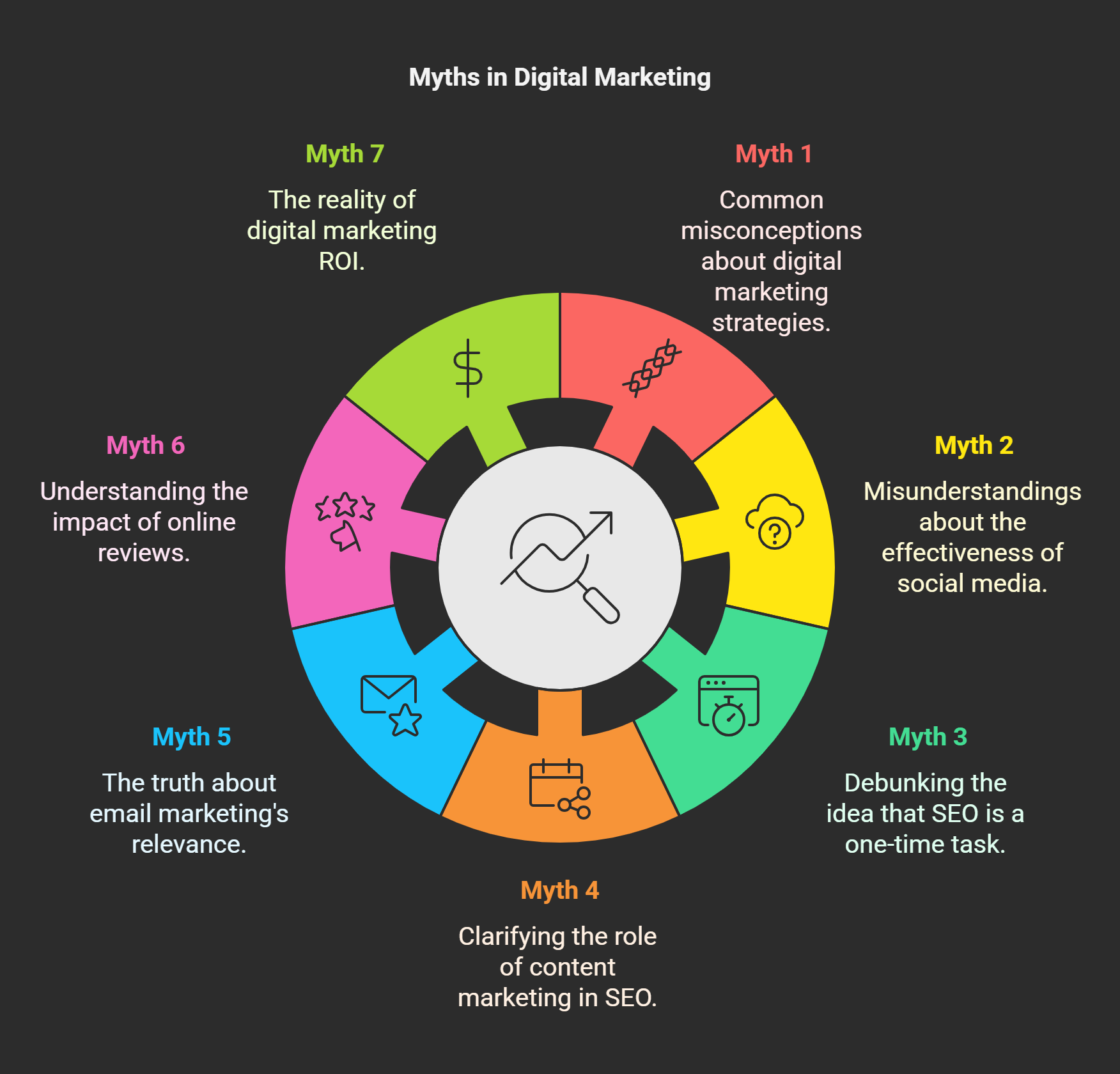I hope you enjoy reading this blog post.
If you want to get more traffic, Contact Us

Click Here - Free 30-Minute Strategy Session
Be quick! FREE spots are almost gone for this Month. Free Quote

Misconceptions surrounding digital marketing can lead to wasted resources, underperforming campaigns, and misallocated budgets. Many businesses invest heavily in strategies based on outdated beliefs without understanding their actual impact. These myths often cloud judgment, resulting in unnecessary expenses and lost opportunities. For instance, blindly following metrics like follower counts or focusing solely on going viral can detract from value-driven marketing.
Common myths can also divert attention from proven techniques, such as data-driven decisions and precise audience targeting. As these falsehoods persist, they misguide efforts, drain finances, and hinder long-term growth. Identifying these myths is crucial for effective planning.

Click Here – Free 30-Minute Strategy Session
Be quick! FREE spots are almost gone for this Month
Digital marketing often gets misrepresented as a quick fix for business growth. While strategies like paid ads or viral content may yield faster visibility compared to traditional methods, sustainable results require time, effort, and consistent optimisation.
Quick results may happen in isolated cases but are not guaranteed. Digital marketing thrives on adaptability and analysing metrics over time to refine methods for long-term success.
Social media platforms may allow users to create profiles and post content without initial costs, but leveraging them effectively for marketing goes beyond free features. Businesses must invest in high-quality content creation, including videos, graphics, and copywriting, to engage audiences and stand out amid growing competition. Paid advertising, such as Facebook Ads or Instagram Promotions, often becomes essential to reach targeted demographics.
Furthermore, skilled personnel or agencies are required to manage accounts, develop campaigns, and analyse performance metrics. Advanced tools like scheduling software and analytics tools also incur expenses. Therefore, while access is technically free, utilising social media as a marketing channel demands consistent financial investment.
Search engine optimisation (SEO) is not a one-time effort but a continuous process that evolves alongside search engine algorithms and user behaviours. Digital landscapes change frequently, requiring businesses to monitor and adjust their strategies regularly.
Ignoring ongoing optimisation can result in decreased visibility and weakened traffic, underscoring the necessity of a long-term commitment.
Paid advertising alone cannot guarantee traffic growth or lead generation. Successful campaigns require a thoughtful, data-driven strategy to target specific audiences and achieve results. Without clear objectives, businesses risk wasting money on ads that don’t align with their goals. Factors like audience segmentation, ad design, and platform selection play a crucial role in performance.
Advertisers must carefully monitor metrics such as click-through rates, conversion rates, and ROI. Testing and optimisation—including A/B testing of headlines, visuals, and calls-to-action—are essential. Ads need meaningful content, addressing user needs, to capture attention. Paid efforts succeed only when aligned with an overarching marketing strategy.
Believing that more content automatically means better results is a common mistake in digital marketing. While frequent updates can keep audiences engaged, low-quality content risks alienating readers and damaging brand credibility. Search engines increasingly prioritise quality over quantity, rewarding original, valuable material instead of keyword-stuffed filler. Marketers should focus on producing well-researched, actionable insights, even if it means less frequent postings. High-quality content fosters trust and encourages sharing, which amplifies online visibility organically. Balancing consistency with substance ensures a brand remains relevant without overwhelming its audience. Assuming quantity is king overlooks the enduring importance of impactful messaging.
Email marketing is far from obsolete and remains one of the most effective digital marketing tools for engaging audiences. Despite misconceptions, email continues to deliver a high ROI for businesses across various industries. Studies show that personalised emails and automated campaigns achieve high open and click-through rates. Furthermore, email marketing complements other digital strategies, seamlessly integrating with social media and content marketing efforts.
Advancements in tools allow businesses to segment audiences, craft tailored messages, and analyse engagement in real-time. The growing use of mobile devices ensures that email remains relevant, as people check their inboxes frequently. Therefore, dismissing email marketing risks missing valuable opportunities.
It is a misconception that analytics tools are exclusive to large corporations with extensive budgets. Businesses of all sizes benefit from data-driven decisions, and modern analytics platforms cater to diverse needs. Small businesses can leverage free or affordable tools, such as Google Analytics, to understand customer behaviour, track conversions, and optimise campaigns.
Analytics empower even micro-sized ventures to pinpoint effective strategies and minimise inefficiencies. The scalability of tools allows businesses to tailor insights to their operations without requiring high financial investments. By embracing analytics, smaller organisations can compete effectively with larger firms, ensuring their marketing efforts yield measurable results.
Recognising and avoiding marketing myths involves critically evaluating common narratives. Begin by questioning claims that sound overly simplistic or universal, as digital marketing strategies often require tailored approaches.
Understanding the difference between proven strategies and baseless assumptions equips marketers to make trusted decisions in an ever-changing landscape.
Making informed budget decisions requires a tangible understanding of digital marketing myths and realities. Misconceptions like universal platform success or the superiority of organic reach over paid efforts can skew financial planning. Emphasising data-driven strategies and ROI analysis ensures marketing budgets align with measurable goals.
Categories like audience demographics, campaign performance metrics, and industry trends help marketers allocate funds more effectively. Clear budget priorities mitigate overspending and underperformance. Additionally, adaptability in budget management based on shifting trends in technology and consumer behaviour secures better returns. This approach positions brands to evolve with the digital landscape while staying financially prudent.

LEAVE A REPLY